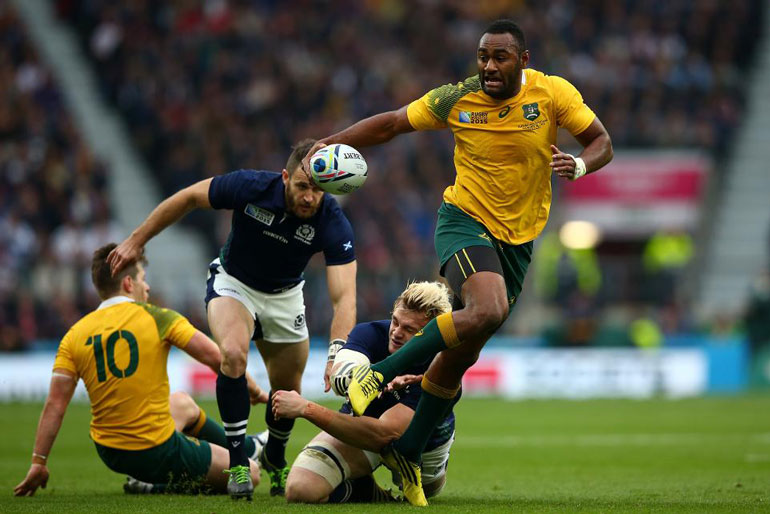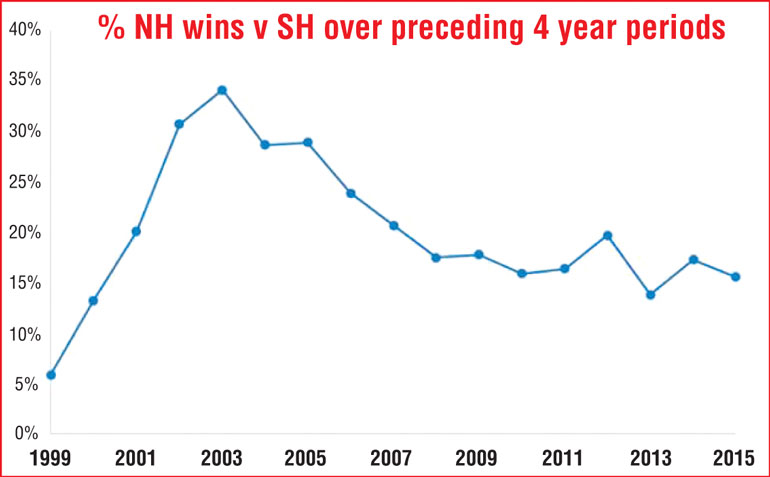Saturday Apr 26, 2025
Saturday Apr 26, 2025
Saturday, 24 October 2015 00:00 - - {{hitsCtrl.values.hits}}

LONDON: With no northern hemisphere nations in the semi-finals of a Rugby World Cup for the first time, the debate has raged in recent days whether the gap with teams from south of the equator is widening. The truth is, northern hemisphere teams have always struggled to beat those from the south, and the margins between them are actually getting smaller.
The notion is based on the lack of a European side for the first time in the semi-finals of the competition. However, comparing the number of northern hemisphere teams in the last four of a Rugby World Cup is a flawed method to illustrate any theoretical gap because it depends on teams from the same hemisphere not meeting in the quarter-finals.
The knockout phase of Rugby World Cup 2011, for example, comprised four northern hemisphere teams on one side of the draw and four from the south on the other. This was partly due to Ireland’s pool phase victory against Australia, but that match was extremely close – as was Wales’ pool match against the Wallabies this time around. Had the Welsh won, it would have guaranteed an all-northern hemisphere quarter-final between Wales and Scotland and therefore a semi-finalist from the Six Nations. That is how small the margins are.
Enormous surprises
Four years earlier, the quarter-finals panned out as they did this year, with the possibility of four southern hemisphere teams in the semi-finals. No one would disagree that England and France’s wins against Australia and New Zealand at RWC 2007 were enormous surprises.
Indeed, it has been shown here that those two matches were two of the seven most surprising results at the past four World Cups. Both those results were far bigger shocks than a Wales win against South Africa last weekend would have been, based on pre-tournament world rankings.
The Rugby Championship teams did win all seven of their matches against their northern counterparts at RWC 2015. However, this is a small number to draw conclusions from, particularly as three of those – Australia’s wins against Wales and Scotland and South Africa’s win against Wales – could have gone either way.
A better way to assess any difference between the standards in the two hemispheres is to look at results over a much longer period than an individual World Cup.
A much more accurate picture is to look at win percentages and winning margins in matches between north and south across four-year periods, which total upwards of 50 games. Given Argentina’s relatively recent rise and Italy’s general failure to compete consistently, the fairest results to choose are those recorded by the former Tri Nations and Five Nations teams.
As the graph 1 shows, northern hemisphere teams struggled to beat opponents from the south immediately after professionalism was introduced in 1995. In the first two full years of the professional era, there were no wins for the north in 23 test matches against the south.
It took until England beat South Africa 13-7 at the end of 1998 for the north to record its first test victory against the south for three years since France beat New Zealand in Toulouse in November 1995.
Rapid progress followed with the north winning about one-third of its matches against Australia, New Zealand and South Africa between 2000 and 2003. That period culminated in England becoming the only world champions from the northern hemisphere.
Northern hemisphere teams had won 17 of the 50 tests against the south between 2000 and 2003 but England and France were responsible for 15 of those victories. By 2007, the north’s success against the south’s big three had dropped to about one match in five and has been below that since.
The success of the north against the southern hemisphere big three has historically depended on England and France, but there are signs this is changing with much closer matches against the south’s big three being recorded by the Celtic nations.
The difference between north and south has reduced by more than a third since 2010. The average margin of victory in these matches has settled at around 10 points, much lower than the 16-point average recorded a few years ago.
So despite results at this World Cup going in favour of the southern hemisphere teams, the signs are that the north as a whole has closed the gap on the south, and suggestions by some pundits that the difference has never been bigger are not backed up by the facts.
Former England international and World Cup winner Mike Tindall said earlier this week: “I do not believe that the gap in standard between northern and southern hemisphere is widening.”
The results of 58 matches between north and south over the past four years confirm this view.

Discover Kapruka, the leading online shopping platform in Sri Lanka, where you can conveniently send Gifts and Flowers to your loved ones for any event including Valentine ’s Day. Explore a wide range of popular Shopping Categories on Kapruka, including Toys, Groceries, Electronics, Birthday Cakes, Fruits, Chocolates, Flower Bouquets, Clothing, Watches, Lingerie, Gift Sets and Jewellery. Also if you’re interested in selling with Kapruka, Partner Central by Kapruka is the best solution to start with. Moreover, through Kapruka Global Shop, you can also enjoy the convenience of purchasing products from renowned platforms like Amazon and eBay and have them delivered to Sri Lanka.
Discover Kapruka, the leading online shopping platform in Sri Lanka, where you can conveniently send Gifts and Flowers to your loved ones for any event including Valentine ’s Day. Explore a wide range of popular Shopping Categories on Kapruka, including Toys, Groceries, Electronics, Birthday Cakes, Fruits, Chocolates, Flower Bouquets, Clothing, Watches, Lingerie, Gift Sets and Jewellery. Also if you’re interested in selling with Kapruka, Partner Central by Kapruka is the best solution to start with. Moreover, through Kapruka Global Shop, you can also enjoy the convenience of purchasing products from renowned platforms like Amazon and eBay and have them delivered to Sri Lanka.